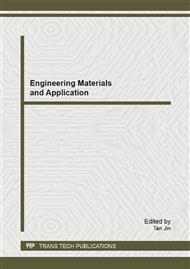[1]
A.H.M. Andreasen, J. Andersen, Über die Beziehungen zwischen Kornabstufungen und Zwischenraum in Produkten aus losen Körnern (mit einigen Experimenten). Kolloid-Zeitschrift 50 (1930) 217-228 (In German).
DOI: 10.1007/bf01422986
Google Scholar
[2]
M. Hunger, H.J.H. Brouwers, Natural stone waste powders applied to SCC mix design. Restor. Build. Monum. 14 (2008) 131-140.
DOI: 10.1515/rbm-2008-6206
Google Scholar
[3]
G. Hüsken, H.J.H. Brouwers, A new mix design concept for earth-moist concrete: A theoretical and experimental study. Cem. Concr. Res. 38 (2008) 1246-1259.
DOI: 10.1016/j.cemconres.2008.04.002
Google Scholar
[4]
Q.L. Yu, H.J.H. Brouwers, Microstructure and mechanical properties of β-hemihydrate produced gypsum: An insight from its hydration proces. Const. Build. Mater. 25 (2011) 3149-3157.
DOI: 10.1016/j.conbuildmat.2010.12.005
Google Scholar
[5]
EN 13454-2. Binders, composite binders and factory made mixtures for floor screeds based on calcium sulfate - Part 2: Test methods, (2004).
DOI: 10.3403/03011796u
Google Scholar
[6]
EFNARC. The European Guidelines for Self-Compacting Concrete Specification, Production and Use. EFNARC, (2005).
Google Scholar
[7]
A.C.J. de Korte, H.J.H. Brouwers, Calculation of thermal conductivity of gypsum plasterboards at ambient and elevated temperature. Fire Mater. 34 (2010) 55-75.
DOI: 10.1002/fam.1009
Google Scholar
[8]
P. Zehner, E.U. Schlunder, Thermal conductivity of granular materials at moderate temperatures. Chemie. Ingeieur. Technik. 14 (1970) 933-941.
Google Scholar
[9]
Q.L. Yu, H.J.H. Brouwers, Thermal properties and microstructure of gypsum board and its dehydration products: a theoretical and experimental investigation. Fire Mater. 36 (2012) 576-589.
DOI: 10.1002/fam.1117
Google Scholar
[10]
Q.L. Yu, Design of environmentally friednly calcium sulfate-based building materials: towards an improved indoor air qualiyt. PhD Thesis, Eindhoven University of Technology, Eindhoven, the Netherlands, (2012).
Google Scholar
[11]
International Organization for Standardization. Fire-resistance tests - Elements of building construction - Part 1: General requirements, ISO, Switzerland. Reference number: ISO 834-1: (1999).
Google Scholar
[12]
J.R. Mehaffey, P. Cuerrier, and G. Carisse, A model for predicting heat transfer through gypsum-board/wood-stud walls exposed to fire. Fire Mater. 18 (1994) 297-305.
DOI: 10.1002/fam.810180505
Google Scholar


